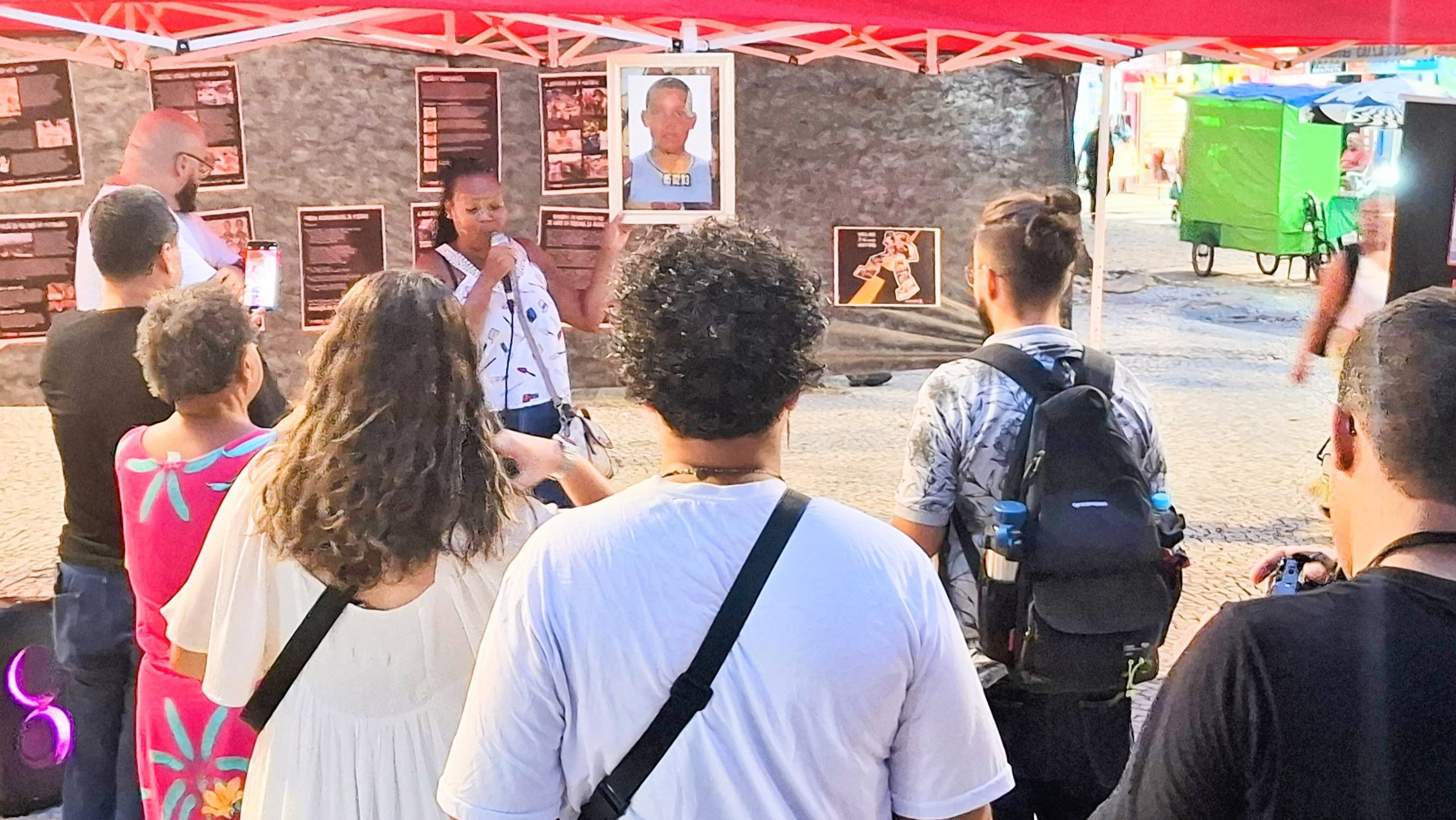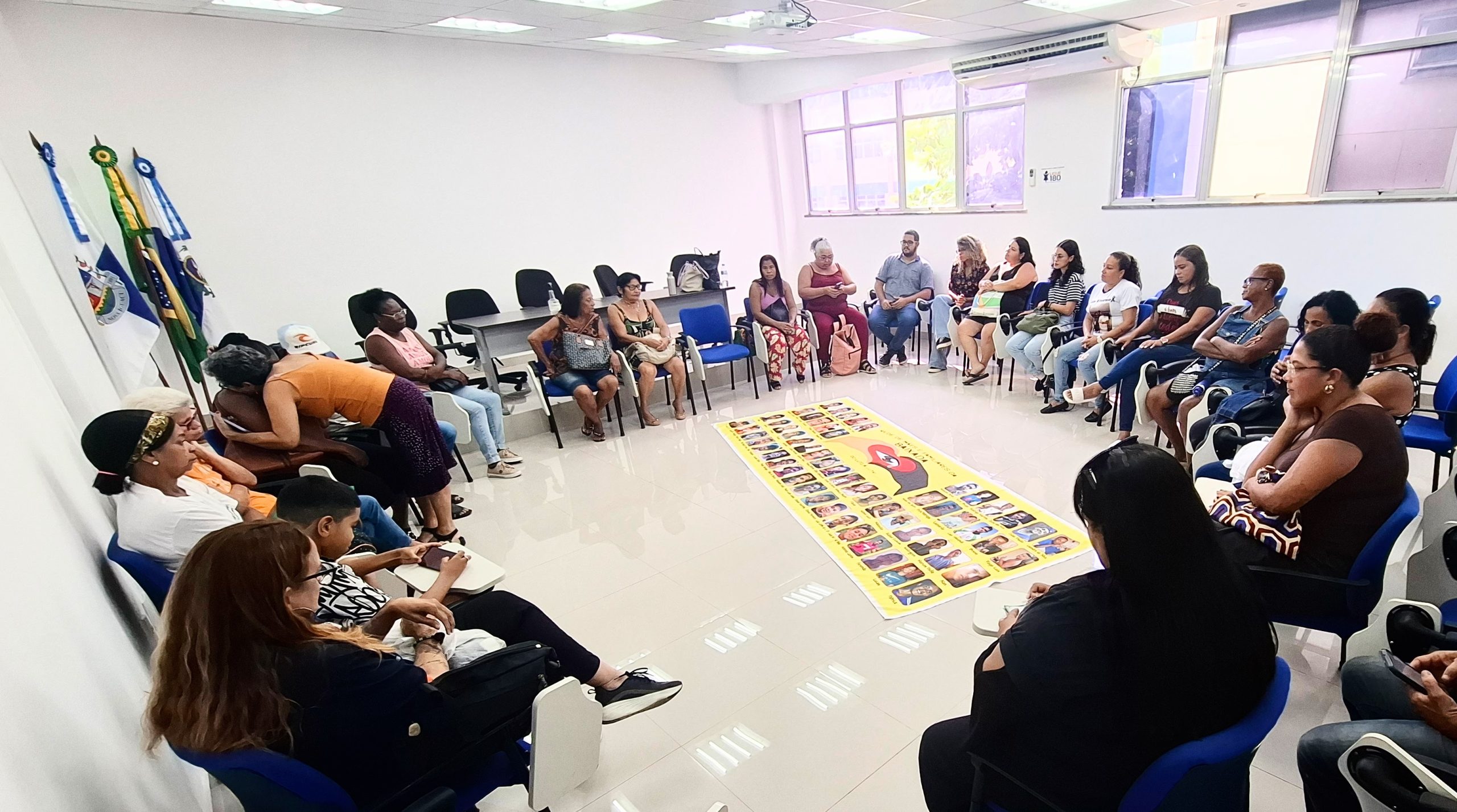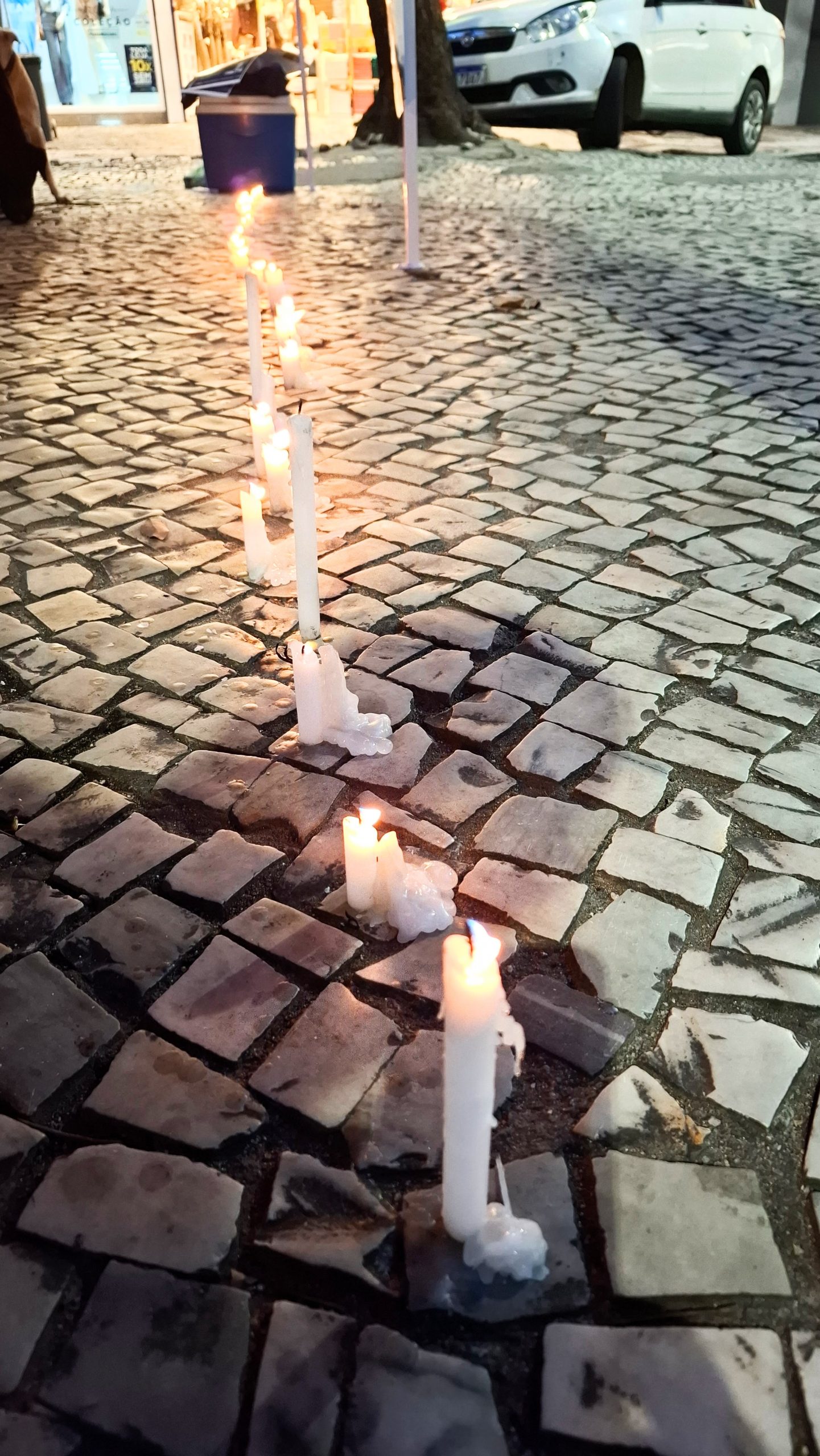
Clique aqui para Português
On the night of March 31, 2005, five Military Police officers—some of whom had previously been accused of police violence—met at a bar in downtown Nova Iguaçu and then drove along the area between Nova Iguaçu and Queimados, in the Baixada Fluminense region of Greater Rio, killing dozens of people at random. According to investigations, the officers were angry at the then-commander of the Duque de Caxias police battalion, who had punished them for misconduct. All five officers directly involved in the massacre were convicted. The last trial took place in 2009, with one of the officers sentenced to 509 years in prison. The crime became known as the Baixada Massacre, in which 29 people—men and women, including youth and adults ranging in age from 13 to 64—were brutally murdered by agents of the State security forces.
The Baixada Massacre continues to haunt the region’s residents. On March 31, 2025—marking 20 years since the most violent massacre in the state of Rio de Janeiro—mothers and relatives of the victims gathered in Nova Iguaçu and Queimados to offer one another support, honor the memory of their loved ones, and raise awareness about State violence. During these gatherings, families revealed that—even now—they fear another massacre, with the same level of violence, could happen at any moment.
The activities marking the 20th anniversary of the Baixada Massacre included a collective support session for mothers and family members of victims of State violence, held at the Nova Iguaçu Municipal Employees’ Institute. In Queimados, there was a demonstration at Praça Nossa Senhora da Conceição and a public hearing at the City Council. The overarching theme across all events was State neglect in providing funeral, financial, physical, and mental health support to impacted families.
Kátia Patrícia da Silva, a Queimados resident and housewife, was one of the relatives of victims present at the Queimados event. In 2005, after leaving a medical appointment in Edson Passos, a neighborhood in the city of Mesquita, the bus taking her home passed a crowd of people. There, she learned that her brother—who had just turned 15—and her cousin’s husband had both been shot and killed.
“My brother was shot in the forehead, and they also killed the owner of the nearby bar. They almost killed a one-year-old baby who was in their mother’s arms. The only reason they didn’t was because she quickly ran inside her house,” recalls da Silva. She says that, in all these years, she never had access to psychological care, which led to a severe case of diabetes.
The increase in cases of diabetes is a common complaint among mothers and relatives of victims. Prolonged psychological distress—caused by post-traumatic stress following the sudden and shocking loss of loved ones—triggers astronomical doses of cortisol and adrenaline, which, when released in excess by the body, can affect blood glucose levels.
Today, da Silva takes three pills daily to manage her diabetes. She says she doesn’t have the money or willpower to go to the gym—one of the medical recommendations she received for controlling the disease. According to da Silva, their mother also became a victim of the tragedy. She explains that, after losing her son, her mother fell into a deep depression and eventually passed away. Over time, both physical and mental exhaustion have made it difficult for da Silva to continue participating in the annual walks along the Presidente Dutra Highway in memory of the massacre’s victims.
“The authorities don’t want to know about us. We die, we’re buried, and that’s it.” — Kátia Patrícia da Silva

The Movement’s Banner Displays a Macabre and Painful Count
In Nova Iguaçu, around 30 mothers and family members gathered in the auditorium of the Municipal Employees’ Pension Institute on the afternoon of March 31. The hum of conversation was interrupted by social worker Luciene Silva, creator of the annual walks held between 2006 and 2020. In their later years, the walks followed a route from the Presidente Dutra Highway—near a car dealership—to Rua Gama, in the Ipiranga neighborhood. Silva is the mother of Raphael, who was 17 when he was murdered in the Baixada Massacre. In 2018, she founded the Network of Mothers and Family Members of Victims of State Violence in the Baixada Fluminense. Today, she coordinates the Municipal Center for Support to Victims of State Violence and Their Families (NAMVIF), linked to the Nova Iguaçu Municipal Secretariat for Social Assistance.
At all public events attended by the Network of Mothers and Family Members of State Violence Victims in the Baixada Fluminense, a banner shows the faces of victims of this violence. Those who follow the network’s work closely may notice that the banner has been frequently resized. At first, it featured photos of the 29 victims of the Baixada Massacre. Over the years, other images were added, including the fatal victims of many other instances of police brutality. In its most recent iteration, the yellow-background banner displays the faces of 50 people—a number that continues to grow due to ongoing State violence.
“We’re going to have to talk to the designer. We’re going to have to add ten more photos to the banner. In the last three months alone, I’ve met with these ten mothers and promised that their children’s faces would be on the banner too.” — Luciene Silva
The graphic designer in question is Naire Ângelo, also a relative of a victim of armed violence. Ângelo is the uncle of Rodrigo Tavares Raposo, a soldier in the Brazilian Army who was murdered, essentially in front of his home, by a militia member in 2015. Raposo was only 18.
“The saddest thing is that most [of the victims are] far too young, Black, and from poor families. In many cases, the bodies don’t even turn up; they just remain as statistics. Every time a group or family member asks me to do some work related to a homicide, I can’t help but remember my nephew, especially because he worked with me for a few months. He was the one who helped customers at the print shop. He was an incredible kid, always so kind and attentive with people.” — Naire Ângelo
In this meeting with mothers and relatives of victims of State violence, Silva also shared a brief—but brutal—overview of the first three months of 2025. She met with a mother who had lost three of her six children—two killed by drug traffickers, one by the police. Her remaining three children now face serious mental health issues as a result of the violent losses. The killings took place in the Danon favela in Nova Iguaçu—an area that gained national notoriety in 2011 after the murder of two boys, Juan Morais and Igor Souza Afonso, who were eleven and 17 years old, respectively. Four Military Police officers involved in the operation that killed them were convicted.

Living with so many deaths has taken a deep toll on the activist and social worker. At the meeting, Silva recalled that March 31 marks the day her son Raphael was killed—and that next month marks the anniversary of the death of her other son, Ronny, who also died under violent circumstances.
“Today, my health is failing. I am mentally exhausted by the annual reminders of my children’s deaths. They will never be forgotten, even if many people think that we don’t have the right to memory. No one, even within the families of these mothers and relatives, wants to hear how much we miss our loved ones. They say that time has passed, that we have to move on with our lives. No one can bear our loneliness, our suffocating daily lives, the care that borders on paranoia and with which we look after our children and grandchildren. We just don’t want anyone else to die.” — Luciene Silva
There Are Few Support Networks for Victims of Urban and State Violence
Elisabeth Oliveira, another member of the Baixada Mothers Network, was also present at the gathering. She is the mother of Vitor Oliveira, who was killed on June 17, 2018, by agents of the State security forces stationed at the 21st Military Police Battalion in São João de Meriti. For Oliveira, known as Beth within the group, all the work involved in engagement, activism, and keeping up with the agenda is marked by mental and emotional strain.
“Our mental health—mine and that of nearly all members of the Baixada Fluminense Mothers’ Network—is very fragile. We get no psychological or psychiatric support from the government to get the medication we need to keep us from dying while still alive.” — Elisabeth Oliveira
Even in poor health, Beth arrived in Brasília the day after the Mothers’ Network meeting, alongside representatives of other social movements from favelas and peripheral areas, to participate in the trial of ADPF 635 (Claim of Non-Compliance with a Fundamental Precept No. 635). Better known as the ADPF of the Favelas, the case challenges public security policies in Rio de Janeiro and seeks measures to reduce police violence.
In response to the State’s negligence, victims’ families and organized civil society have created their own mechanisms, such as psychosocial support networks. The near-total absence of support policies for these families reflects the authorities’ lack of political will to address a problem the State itself creates—either directly, through police forces and the failure to investigate acts of police violence, or indirectly, when after massacres and extrajudicial executions, the State fails to create or implement robust public policies to support the families of victims “who die while still living.”
However, some initiatives show that, while it’s no easy task, it is indeed possible to offer support to those who suffer such losses—including with the involvement of civil society. On December 15, 2021, for example, the city of Nova Iguaçu, together with civil society organizations, movements, and citizens, launched the Municipal Center for Support to Victims of State Violence and Their Families (NAMVIF), a groundbreaking project in Brazil, linked to the city’s Secretariat for Social Assistance.
“Initially, we called upon all municipal secretariats that could take part in our work, along with various representatives from civil society, because this is not something we can do alone. We’ve been able to raise awareness among professionals working in the Social Assistance system, such as the Social Assistance Reference Centers (CRAS) and the Specialized Social Assistance Reference Centers (CREAS). But it’s a slow process. Unfortunately, many of the staff who took part in training sessions for mothers and family members affected by urban and State violence are no longer in Nova Iguaçu, so we’ll have to think about how to restart that entire process. On top of that, there are new staff members coming in, since the City recently held a public hiring process in the Social Assistance sector. We’re basically going to have to start from scratch.” — Luciene Silva
The challenges to providing humane and effective care, however, remain immense. So says Adriano de Araujo, executive coordinator of Grita Baixada Forum—one of the Baixada Fluminense organizations that worked on coordination and political advocacy with the Mothers’ Network to help create NAMVIF.
“[Challenges include] changes in leadership and directives after each election cycle, the heavy workload faced by social assistance professionals and public servants, personal and professional insecurity in the face of an innovative project (that, for this exact reason, offers no guarantees or established references), and the very real fear of dealing with issues like lethal violence and forced disappearances in the Baixada Fluminense.” — Adriano de Araujo
In addition to NAMVIF, the Network for Assistance to People Affected by State Violence (RAAVE) was created in 2022. It is an extension of the work carried out by the psychosocial team at the Nucleus for the Defense of Human Rights (NUDEH) within the Rio de Janeiro State Public Defender’s Office. Attorney Guilherme Pimentel, one of RAAVE’s coordinators, explains that, in addition to coordinating with Brazil’s Unified Health System (SUS) and Unified Social Assistance System (SUAS) policies, the organizations in the network are regarded as key partners in the defense and guarantee of rights of those impacted by State violence.
“One of RAAVE’s goals is to strengthen psychosocial health so that people have the capacity to keep fighting. It’s yet another approach on how to offer this type of care, recognizing that those being supported are not only recipients, but also producers of knowledge and creators of public policy.” — Guilherme Pimentel

What if the Massacre Had Taken Place in Copacabana or Leblon?
The event in Queimados ended with participants lighting 29 candles in honor of the Baixada Massacre victims. Afterwards, about 30 people—many of them local residents and representatives of community organizations such as the Kunta Kinte Cultural Center—walked to the Queimados City Council for a solemn session on violence in the region. One of the guests, lawyer and human rights defender Rodrigo Mondego, called attention to the institutional cruelty of those who should be protecting lives.
“Those who were supposed to prevent crime ended up committing the worst of them: murder. The Baixada Fluminense has long had a history of killings. And the largest massacre in the region was carried out by those who were meant to stop more deaths from happening.” — Rodrigo Mondego
He also pointed out how the geography of a peripheral city plays a key role in what he calls “repercussion selectivity.” According to the lawyer, the farther a region is from economic and power centers, the less mainstream media reports and demands answers from the State.
“The biggest massacre in the state of Rio turned 20, and I didn’t see a single major news outlet or TV channel do an in-depth story on it. And look: the number of children killed was higher than in the Candelária Massacre, but the repercussion of the latter was infinitely greater, because it happened in downtown Rio, next to a postcard-worthy setting, not in some municipality in the Baixada Fluminense. Imagine the media coverage if 29 people had been massacred in Copacabana or Leblon.” — Rodrigo Mondego
About the author: Fabio Leon is a journalist, human rights activist, and media advisor with Fórum Grita Baixada.
